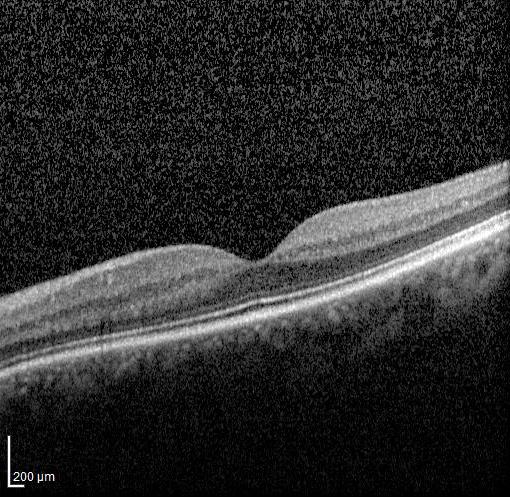Diagnostic Techniques
Flourescin Angiography (FA)
Flourescin angiography is a diagnostic test used to help physicians identify eye conditions impacting circulation within the eye. The diagnostic testing lasts around 30 minutes.
Flourescin angiography begins first by dilating the eyes. An injection is given in the arm, which contains a yellow dye known as flourescin. The dye is injected within the arm, and the dye travels up to the eye. If there is any pathology within the eye, the flourescin dye will allow an Opthalmologist to clearly view the location of a damaged vein, artery, or other impacted structures within the eye. An ophthalmologist will use a specialized camera to clearly view the portions of the eye that may signify pathology.
No there are typically not any long-term effects of flourescin angiography. Typically symptoms subside within a minutes to about 24 hours after the dye is injected. When the dye is injected, some of it may come into contact with the skin. A slight burning sensation may occur, which will last for a few minutes, and quickly subside. When viewing objects, they could appear slightly darkened. This will not last more than a few minutes after the injection. Urine may appear a dark yellow or orange and will return to normal after 24 hours. This is typically due to the fact that the kidneys will filter the dye out of the body. Lastly, skin may appear somewhat yellow. Skin will return to yellow after a few hours. Very rarely, there may be a risk of an allergic reaction, which would immediately be treated.
Immediately after the procedure, sunglasses would be needed. Vision may appear blurry and exhibit sensitivity to light. A person may need a ride home, so it is advised to bring someone along to assist with transportation.

Optic Coherence Tomography (OCT)
Optic Coherence tomography is a diagnostic technique used to take detailed images of the eye. Typically testing is completed within 10 minutes. An ophthalmologist may dilate the eyes, although some may choose not to. A patient typically will use a supporting cushion to allow the head to remain still. The machine will then scan the eyes, generating images. This is a noninvasive procedure.
This procedure is helpful in diagnosing several conditions that affect the retina, the macula, the vitreous, and lastly, the optic nerve.
There are typically no long-term risks regarding optic coherence tomography. Vision may be slightly blurred, but overall, no long-term risks have been known to occur.

Indocyanine Green Angiography
The Indocyanine Green Angiography is a diagnostic technique that is similar to Flourescin angiography. A Indocyanine Green dye is injected in the arm, and the dye eventually reaches the eye. This procedure is sometimes used along with Flourescin angiography because Indocyanine Green Angiography usually highlights the health of the choroid, while the Flourescin Angiography highlights pathology in the retina. A red infrared light camera is used to illuminate the dye and take images of the choroid and surrounding structures.
The Indocyanine Green Angiography does not typically have any long-term risks associated with it. The short-term side effects are similar to flourescin angiography.
Heidelberg Retinal Tomography
The Heidelberg retinal tomography is used to diagnose glaucoma. A laser is used to scan the retina, optic nerve, and determine the presence of signs of glaucoma. Oftentimes, early signs of cupping can begin, which is when there a loss of cells within the optic nerve, leading to symptoms of glaucoma.
Dilated Retinal Exam
This is an exam in which the pupil is dilated to be able to visualize the structures of the eye as well as the retina. The retina is assessed to determine any visual pathology
Visual Grid test/Amsler grid test
The Amsler Grid test is used to detect macular degeneration. Based on the grid, symptoms of macular degeneration may be present. While viewing the dot in the center, patients with macular degeneration may observe wavy lines, inability to view the corners of the grid, and seeings gaps in the grid.
A and B scans
The B scans are ultrasound scans are used to view the inner structures of the eye. The ultrasound waves help to visualize the individual structures of the eye and determine pathology. A scans help to view peripheral regions of lesions that may be present.
This procedure is helpful in diagnosing several conditions that affect the retina, the macula, the vitreous, and lastly, the optic nerve.
There are typically no long-term risks regarding optic coherence tomography. Vision may be slightly blurred, but overall, no long-term risks have been known to occur.

Request an
Appointment
Opening Hours
Calls are taken 24/7 for emergencies
Available on Saturday and Sunday for Emergency only. Call for appointment
LOCATIONS AND DIRECTIONS





Request an
Appointment
Opening Hours
Calls are taken 24/7 for emergencies
Available on Saturday and Sunday for Emergency only. Call for appointment
LOCATIONS AND DIRECTIONS







